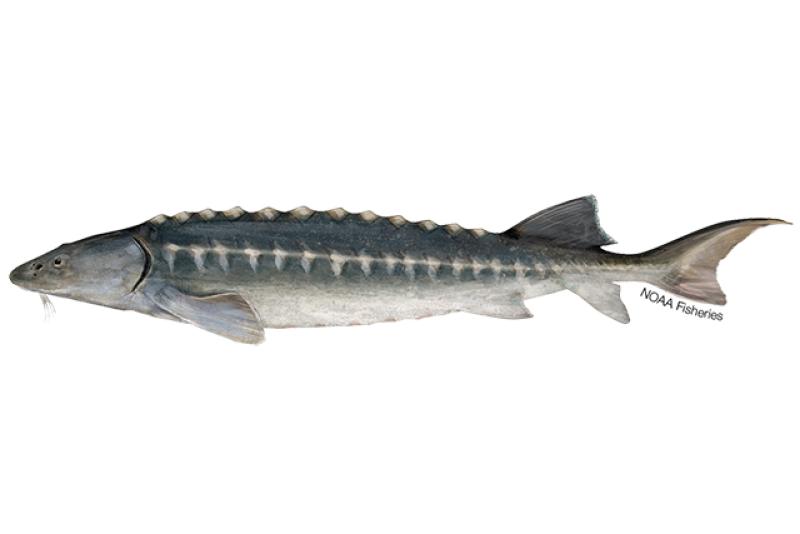Atlantic Sturgeon
Acipenser oxyrinchus oxyrinchus
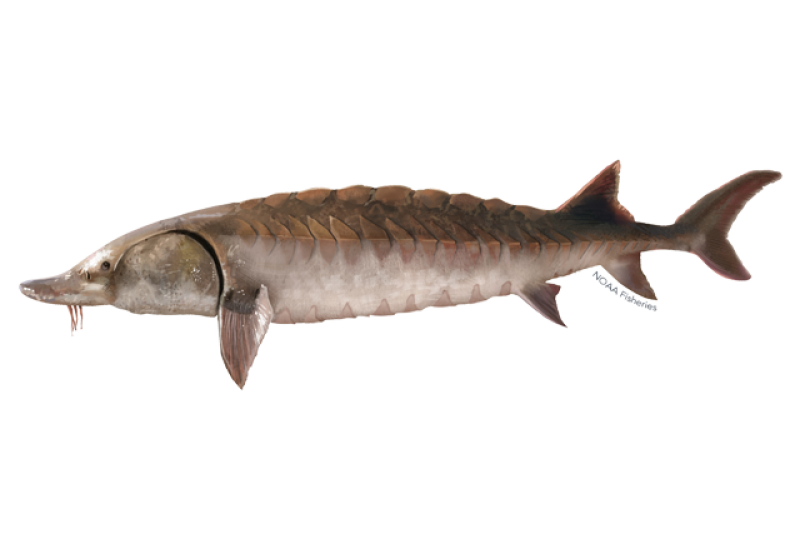
Protected Status
Chesapeake Bay DPS
New York Bight DPS
South Atlantic DPS
Quick Facts
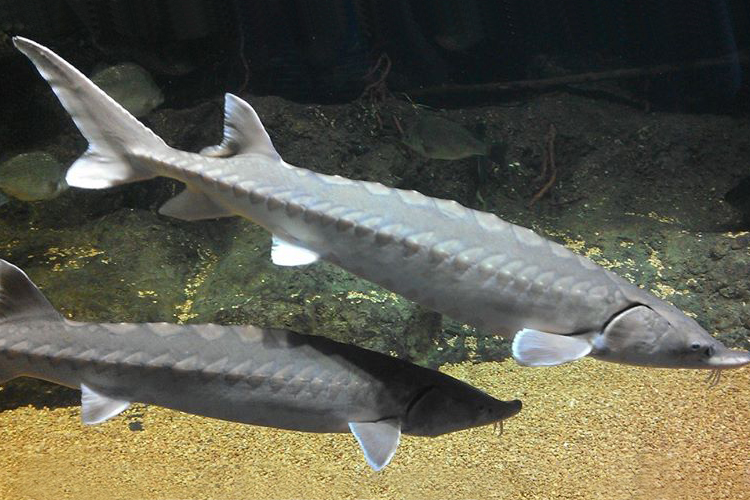 Atlantic sturgeon swimming. Credit: NOAA Fisheries
Atlantic sturgeon swimming. Credit: NOAA Fisheries
Atlantic sturgeon swimming. Credit: NOAA Fisheries
About the Species
 Atlantic sturgeon swimming. Credit: NOAA Fisheries
Atlantic sturgeon swimming. Credit: NOAA Fisheries
Atlantic sturgeon swimming. Credit: NOAA Fisheries
Atlantic sturgeon live in rivers and coastal waters from Canada to Florida. Hatched in the freshwater of rivers, Atlantic sturgeon head out to sea as sub-adults, and return to their birthplace to spawn, or lay eggs, when they reach adulthood.
The Atlantic sturgeon has five rows of bony plates known as scutes that run along its body and a snout with four slender, soft tissue projections called barbels in front of its mouth. In addition, the tail is like a shark’s where one side, or lobe, is larger than the other. All of these features give the fish its unique look.
Atlantic sturgeon are slow-growing and late-maturing, and have been recorded to reach up to 14 feet in length and up to 60 years of age.
Indigenous tribes have harvested Atlantic and shortnose sturgeon for their meat and eggs (roe) beginning some 4,000 years ago, and sturgeon are credited as the primary food source that saved the Jamestown settlers in 1607. Atlantic sturgeon were once found in great abundance, but their populations have declined greatly due to overfishing and habitat loss. Atlantic sturgeon were prized for their eggs, which were valued as high-quality caviar. During the late 1800s, people flocked to the eastern United States in search of caviar riches from the sturgeon fishery, known as the “Black Gold Rush.” By the beginning of the 1900s, sturgeon populations had declined drastically. Close to 7 million pounds of sturgeon were reportedly caught in 1887, but by 1905, the catch declined to only 20,000 pounds. By 1989, only 400 pounds of sturgeon were recorded. However, historical landings records generally failed to differentiate between Atlantic sturgeon and the smaller shortnose sturgeon, making it difficult to determine historical trends in abundance for populations of either species.
Today, all five U.S. Atlantic sturgeon distinct population segments are listed as endangered or threatened under the Endangered Species Act. The populations in Canada are not protected species under the U.S. Endangered Species Act. The primary threats currently facing Atlantic sturgeon are entanglement in fishing gear, habitat degradation, habitat impediments, such as dams and other barriers, and vessel strikes.
NOAA Fisheries and our partners are dedicated to conserving and rebuilding Atlantic sturgeon populations along the East Coast. We use a variety of innovative techniques to study, protect, and recover these endangered fish. Working closely with our partners, we develop regulations and management plans that preserve and restore sturgeon habitat, monitor bycatch, and promote population recovery.
Population Status
The historical and current range of Atlantic sturgeon includes major estuaries and river systems from Canada to Florida. While still found throughout their historical range, Atlantic sturgeon spawning is known to occur in only 22 of 38 historical spawning rivers. Adult and sub- adults Atlantic sturgeon also range widely throughout the marine environment.
Learn more about the population estimates for Atlantic sturgeon
Atlantic sturgeon were listed under the ESA in 2012 as five distinct population segments. A distinct population segment is the smallest division of a species permitted to be protected under the ESA. Atlantic sturgeon that hatch out in Gulf of Maine rivers are listed as threatened, and those that hatch out in other U.S. rivers are listed as endangered. Atlantic sturgeon that hatch out in Canadian rivers are not listed as protected species under the ESA.
Appearance
Atlantic sturgeon can grow to approximately 16 feet long and can weigh up to 800 pounds. They are bluish-black or olive brown dorsally (on their back) with paler sides and a white belly. They have five major rows of dermal "scutes,” or bony plates, along the length of their body.
Atlantic sturgeon are similar in appearance to shortnose sturgeon but can be distinguished by their larger size, smaller mouth, different snout shape, and tail scute pattern.
Behavior and Diet
Spawning runs of Atlantic sturgeon are still not completely understood. In rivers from Georgia to the Chesapeake Bay, scientists have confirmed that adult sturgeon spawn during the late summer and fall. In rivers from Delaware to Canada, adults spawn in the spring and early summer. There is information to suggest that some rivers may support both a fall and a separate spring spawning population.
After spawning, males in northern rivers may remain in the river or lower estuary until the fall; females typically exit the rivers within 4 to 6 weeks after spawning. In southern rivers, males usually enter the river in late summer when temperatures can be as high as 90°F, spawn as river temperatures approach 75 to 70°F, with females leaving immediately after spawning and males leaving as temperatures drop below 65°F.
Upon hatching, larvae hide along the bottom and drift downstream until they reach brackish waters where they may reside for 1 to 5 years before moving into nearshore coastal waters. Juvenile fish can leave their natal rivers as early as 1 year of age, so sometimes juvenile aggregations within a river may be composed of two or more different natal populations of fish. Tagging data indicate that these immature Atlantic sturgeon travel widely once they leave their birth rivers.
Atlantic sturgeon are bottom feeders. They typically consume invertebrates, such as crustaceans, worms, and mollusks, and bottom-dwelling fish, such as sand lance.
Where They Live
Historically, Atlantic sturgeon ranged along the Canadian and U.S. Atlantic Coast from Labrador to Florida. Due to overfishing, the abundance of natal populations is much less than historical levels, but breeding populations still exist in at least 22 U.S. rivers from Maine to Georgia and in several more in Canada. Atlantic sturgeon are anadromous fish—they are born in freshwater and then migrate to the sea and back again to freshwater to spawn. Most juveniles remain in their river of birth (natal river) for at least several months before migrating out to the ocean. Tagging data indicate that these immature Atlantic sturgeon travel widely up and down the East Coast and as far as Iceland when they are at sea.
Lifespan & Reproduction
Atlantic sturgeon lifespan is correlated with how far north or south they live. They live up to 60 years in Canada but likely only 25 to 30 years in the Southeast. Southern populations typically grow faster and reach sexual maturity earlier than northern populations. For example, Atlantic sturgeon mature in South Carolina rivers at 5 to 19 years of age, in the Hudson River at 11 to 21 years, and in the Saint Lawrence River at 22 to 34 years.
Atlantic sturgeon spawning intervals range from 1 to 5 years for males and 2 to 5 years for females, with males returning almost every year and females usually returning every other year or every third year. Female egg production correlates with age and body size, and ranges from 400,000 to 2 million eggs. Atlantic sturgeon take approximately 3 to 10 times longer than other bony fish species to reach 50 percent of their maximum lifetime egg production. In the Hudson River, females reach 50 percent of their maximum lifetime egg production at approximately 29 years. Fish from more southern rivers reach this production metric at an earlier age and fish from Maine and Canada reach it at a later age.
Threats
The most significant threats to Atlantic sturgeon are unintended catch (bycatch) in some commercial fisheries, dams that block access to spawning areas, poor water quality (which harms development of sturgeon offspring), dredging of spawning areas, water withdrawals from rivers, and vessel strikes.
Fisheries Interactions and Bycatch
Bycatch of Atlantic sturgeon occurs primarily in gillnet and trawl fisheries. The prevalence and likelihood of bycatch varies by fishing season. The fishing season also impacts the likelihood of sturgeon survival, which is more likely in cooler waters. Fisheries conducted within rivers and estuaries may intercept Atlantic sturgeon of any life stage, while fisheries conducted in the nearshore and ocean waters are more likely to capture juveniles and adults.
Learn more about fishing gear and risks to protected species
Habitat Degradation
Atlantic sturgeon habitat can be disrupted, degraded, or lost because of various human activities, such as dredging, damming, and withdrawing water. Groundwater pumping and dredging has resulted in saltwater intrusion, and industrialization and development has impacted sediments and water quality through the introduction of nutrients and other contaminants. Sturgeon need hard bottom substrates in freshwater reaches for successful spawning, so any activity that affects those features directly (e.g., dredging) or indirectly (e.g., sedimentation or saltwater intrusion) would affect Atlantic sturgeon habitat. All life stages of Atlantic sturgeon also require sufficient water quantities and qualities, which are often impacted by the activities above.
Habitat Impediments
Locks and dams on the Cape Fear River, North Carolina; the Santee-Cooper rivers, South Carolina; Savannah River, South Carolina/Georgia impede access to upstream spawning habitat. Recent dam removal projects on the Penobscot River, Maine and Rappahannock River, Virginia, have increased accessibility to upstream habitats.
Vessel Strikes
Atlantic sturgeon can be struck by boats or by the blades of boats’ propellers. They are struck and killed by large commercial vessels as well as smaller vessels such as recreational vessels. The risk of injury and mortality can be high in areas with high ship traffic, including the Hudson, Delaware, and James rivers. Information is emerging that suggests vessel strikes are also a threat to Atlantic sturgeon in the Savannah, Cooper, and Cape Fear rivers. We do not know how many sturgeon are struck by vessels and survive their injuries.
Scientific Classification
| Kingdom | Animalia | Phylum | Chordata | Class | Actinopterygii | Order | Acipenseriformes | Family | Acipenseridae | Genus | Acipenser | Species | oxyrinchus |
|---|
Last updated by NOAA Fisheries on 05/22/2025
What We Do
Conservation & Management
We are committed to the protection and recovery of the Atlantic sturgeon through implementation of conservation, management, and enforcement measures. Our work includes:
- Preserving existing habitat
- Improving existing habitat and restoring access to historical habitat (e.g., dam removals)
- Monitoring bycatch and stock recovery
- Supporting U.S. FWS and state-run captive breeding and research programs
- Educating the public
Science
We conduct research or work with research partners to gain understanding of the biology behavior, and ecology of the Atlantic sturgeon. The results are used to inform management decisions and enhance recovery efforts for this imperiled species. Our work includes:
- Identifying critical habitat and when it is used by the species
- Conducting stock assessments and collecting population information
- Tracking individuals over time to monitor important behaviors
- Studying genetic characteristics and relationships among individuals and populations
How You Can Help
Know the Law Before You Fish
It is illegal to fish for, catch, or keep sturgeon—including Atlantic, Shortnose, and Gulf. If you accidently hook a sturgeon, be prepared to catch and release with care.
Report a Stranded, Injured, or Dead Sturgeon
If you find a stranded, injured, or dead sturgeon, please report it to NOAA Fisheries at (978) 281-9328 or in the Southeast at (844) STURG-911 or (844) 788-7491, or send us an email at noaa.sturg911@noaa.gov.
Report a Violation
Call the NOAA Fisheries Enforcement Hotline at (800) 853-1964 to report a federal marine resource violation. This hotline is available 24 hours a day, 7 days a week for anyone in the United States.
You may also contact your closest NOAA Office of Law Enforcement field office during regular business hours.
Learn About Bycatch
One of the main threats to marine animals is entanglement in fishing gear, especially gillnets. Fishermen sometimes catch and discard animals they do not want, cannot sell, or are not allowed to keep. This is collectively known as bycatch.
Featured News
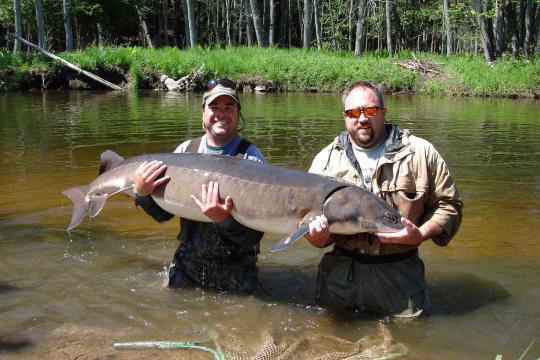 Fishery biologists Tim Cwalinski from the Michigan Department of Natural Resources (left) and Brett Fessell from the Grand Traverse Band of Ottawa and Chippewa Indians (right ) cradle a 140-plus pound female lake sturgeon sampled during spring spawning surveys in the Black River, Cheboygan County. Credit: Grand Traverse Band Restoration Section.
Fishery biologists Tim Cwalinski from the Michigan Department of Natural Resources (left) and Brett Fessell from the Grand Traverse Band of Ottawa and Chippewa Indians (right ) cradle a 140-plus pound female lake sturgeon sampled during spring spawning surveys in the Black River, Cheboygan County. Credit: Grand Traverse Band Restoration Section.
Michigan Tribe to Restore Fish Passage for Native Great Lakes Fish Species
 A coho salmon swims up the Sol Duc river on the Olympic Peninsula. Credit: Adobe Stock.
A coho salmon swims up the Sol Duc river on the Olympic Peninsula. Credit: Adobe Stock.
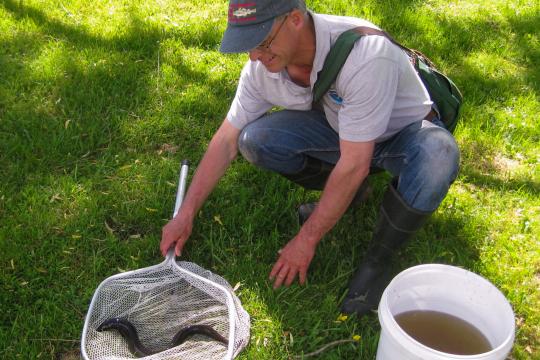 Eric catches an American eel for an educational event about migratory fish. (Photo: Samuel Coulbourn)
Eric catches an American eel for an educational event about migratory fish. (Photo: Samuel Coulbourn)
 Southern Resident killer whale swimming with calf. Credit: NOAA Fisheries
Southern Resident killer whale swimming with calf. Credit: NOAA Fisheries
Recommended 2024 Species Recovery Grants Projects
Management Overview
The Atlantic sturgeon New York Bight distinct population segment (DPS), Chesapeake Bay DPS, Carolina DPS, and Southern Atlantic DPS are listed as endangered and the Gulf of Maine DPS is listed as threatened under the Endangered Species Act.
Additionally, the Atlantic sturgeon is listed under:
- Appendix II of the Convention on International Trade in Endangered Species of Wild Fauna and Flora (CITES)
Recovery Planning and Implementation
Recovery Outline
NOAA Fisheries developed a recovery outline to commence the recovery planning process for Atlantic sturgeon. The outline is meant to serve as an interim guidance document to direct recovery efforts, including recovery planning, for the endangered New York Bight, Chesapeake Bay, Carolina, and South Atlantic DPSs of the Atlantic sturgeon and the threatened Gulf of Maine DPS until a full recovery plan is developed and approved.
Species Recovery Contacts
- Carolina and South Atlantic DPSs: Andrew Herndon
- Gulf of Maine, New York Bight, and Chesapeake Bay DPSs: Lynn Lankshear
Critical Habitat Designation
When a species is listed under the ESA, NOAA Fisheries evaluates and identifies whether any areas meet the definition of critical habitat. Those areas may be designated as critical habitat through a rulemaking process. The designation of an area as critical habitat does not create a closed area, marine protected area, refuge, wilderness reserve, preservation, or other conservation area; nor does the designation affect land ownership. Federal agencies that undertake, fund, or permit activities that may affect these designated critical habitat areas are required to consult with NOAA Fisheries to ensure that their actions do not adversely modify or destroy designated critical habitat.
On August 17, 2017, we designated critical habitat for each of the five listed DPSs. The critical habitats include spawning and rearing areas and essential water quality and water quantity features necessary for Atlantic sturgeon survival.
- Maps of Designated Critical Habitat Rivers for the Gulf of Maine, New York Bight, and Chesapeake Bay DPSs
- Maps of Designated Critical Habitat Rivers for the Carolina and South Atlantic DPSs

Conservation Efforts
Restoring Habitat and Fish Passage
Sturgeon and other migrating fish, such as salmon, shad, and alewives, need access to freshwater habitat for spawning and rearing. In some cases, Atlantic sturgeon need to swim thousands of miles through the oceans and rivers to reach their destination, but they may be blocked from completing their journey by man-made barriers, such as dams. These barriers have had serious impacts on Atlantic sturgeon spawning runs along the entire East Coast, particularly in the Southeast. Removal of outdated dams or providing ways for fish to get around those dams can greatly improve Atlantic sturgeon access to historical habitats. NOAA Fisheries works with conservation organizations, energy companies, states, tribes, and citizens to evaluate barriers and improve fish passage. Most barriers have the same general impact on fish—blocking migrations—but each requires a specific set of conservation actions.
Learn more about improving fish passage
The Penobscot River—New England’s second largest river—has been designated a NOAA Habitat Focus Area, as human activities have caused adverse impacts to the watershed. Recovery of endangered and threatened Atlantic sturgeon, shortnose sturgeon, and Atlantic salmon are a key objective of the ongoing habitat improvement efforts.
Learn more about the Penobscot River Habitat Focus Area
Providing Captive Breeding Programs
Some Atlantic sturgeon are bred and held in captivity at research facilities, in accordance with specific permits. These captive-bred animals can provide important insight into the physical, chemical, and biological parameters necessary for the optimal growth, survival, and reproduction of Atlantic sturgeon in the wild. Some captive-bred animals are also used in permanent educational displays that promote public awareness of the plight of the species.
Educating the Public
One of the best ways to help save this amazing species is through outreach. Our biologists work with students and teachers to share information about the movements, behavior, and threats to Atlantic and shortnose sturgeons along the East Coast. The Students Collaborating to Undertake Tracking Efforts for Sturgeon (SCUTES) program provides lesson plans, educational kits, and an opportunity for classrooms to adopt a tagged sturgeon.
Learn more about the SCUTES program
Cooperating Internationally
The Convention on International Trade in Endangered Species of Wild Fauna and Flora (CITES) protects Atlantic sturgeon and other sturgeons by regulating international trade in listed species of plants and animals.
Key Actions and Documents
Incidental Take Permit to Hudson River Sloop Clearwater, Inc
Incidental Take Permit to Georgia Department of Natural Resources
Incidental Take Permit to North Carolina Division of Marine Fisheries (Sea Turtles and Sturgeon)
- Notice; Issuance of Permit (89 FR 82573, 10/11/2024)
- Notice of Availability - Draft Environmental Assessment (88 FR 54303, 08/10/202…
- Correction to Receipt of Application (88 FR 859, 01/05/2023)
- Receipt of application (87 FR 78659, 12/22/2022)
Incidental Take Permit to Midwest Biodiversity Institute
Last updated by NOAA Fisheries on 05/22/2025
Science Overview
NOAA Fisheries conducts or supports research on the biology, behavior, and ecology of the Atlantic sturgeon. This research informs management decisions and enhances recovery efforts for endangered and threatened Atlantic sturgeon populations.
Tagging and Tracking
Scientists are using tagging techniques to learn about the migration patterns of Atlantic sturgeon and identify important juvenile habitats. Dart, passive integrated transponder (PIT), radio, satellite, pop off, and acoustic tags are commonly used types of tags. Tags, such as PIT tags and dart tags, allow for an individual fish to be identified by other researchers when it is captured. Acoustic and satellite telemetry tags provide researchers with data on where Atlantic sturgeon migrate, at what depths, and at what speeds.
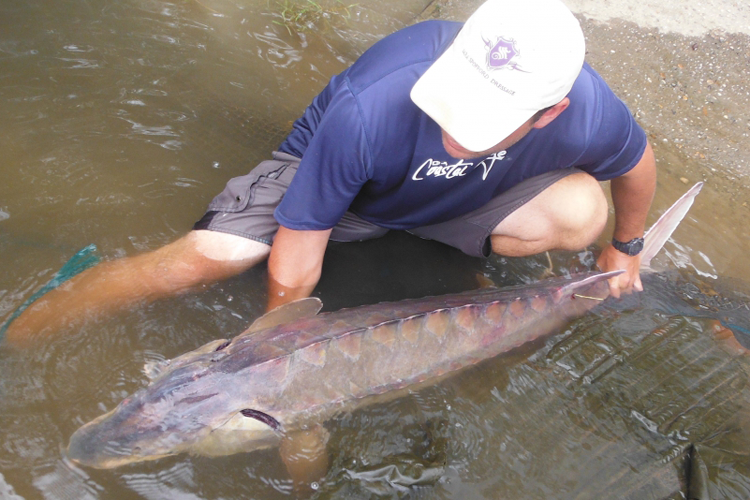
Genetics
Researchers take small fin clips from sturgeon they catch to better understand the genetic composition of the populations. Tissue samples from sturgeon spawning (releasing or depositing eggs) in a particular river can be taken and analyzed to create baselines of the unique genotypes (the genetic makeup of an individual) found in each spawning population. Those baselines allow sturgeon to be identified back to their natal river. For instance, Atlantic sturgeon that are accidentally captured or killed in non-research-related projects can be matched to the river where they were born using their genotype.
Genetic variation (“heterogeneity”) within the population can also be used to estimate the minimum number of spawning adults that would have been required to generate that level of heterogeneity. This information helps us learn more about the approximate number of successfully spawning adults, their natal river, and their family history. NOAA Fisheries, in cooperation with the U.S. Geological Survey, has been maintaining stored tissue and DNA samples and records of Atlantic sturgeon, as well as shortnose sturgeon.
NOAA Fisheries, in partnership with numerous federal and academic researchers, estimates and monitors effective population size of the spawning populations that have been adequately sampled. While effective population sizes are not easily translated to actual abundance estimates, they can provide a rough comparison between populations to better understand relative abundance and threats of inbreeding or extirpation. The most recent estimates of effective population size, from north to south are:
- St. Lawrence River - between 28 and 44 individuals
- St. John River - between 75 and 104 individuals
- Kennebec River - between 52 and 89 individuals
- Connecticut River - between 2 and 3 individuals
- Hudson River - between 138 and 176 individuals
- Delaware River - between 34 and 46 individuals
- James River - between 29 and 36 individuals
- York River - between 6 and 12 individuals
- Albemarle Sound (likely Roanoke River population) - between 16 and 21 individuals
- Edisto River - between 52 and 69 individuals
- Savannah River - between 103 and 150 individuals
- Ogeechee River - between 23 and 29 individuals
- Altamaha River - between 128 and 175 individuals
- Satilla River - between 18 and 23 individuals
- St. Marys River - between 1 and 2 individuals
Side Scan Sonar
Side scan sonar has been used to approximate the number of sturgeon that appear on the resulting images. However, this approach is still being perfected. Most rivers are also too large to allow for sampling of the entire river. Corrections are therefore needed to account for unsampled areas as well as fish that are counted multiple times during surveys.
Reducing Bycatch
We have funded research on new fishing gear configurations that maintain catch rates of the target species but limit bycatch of Atlantic sturgeon. For gill nets, using a raised footrope has shown promise for some fisheries. For trawls, turtle excluder devices are also effective at keeping Atlantic sturgeon out.
The likelihood of mortality of incidentally gill-netted Atlantic sturgeon appears to be related to water quality, how the net is set, and the length of time before the net is tended. Atlantic sturgeon incidentally captured in cooler waters have a greater likelihood of survival than those captured in warmer waters. Anchored gill nets (i.e., set on the bottom, as opposed to floating at the surface) tend to pose the greatest risk for mortality of Atlantic sturgeon, compared to other gill nets or types of gear. Atlantic sturgeon incidentally captured in cooler waters have a greater likelihood of survival than those captured in warmer waters.
Stock Assessment
In 2013, the Atlantic States Marine Fisheries Commission initiated a coastwide population assessment for Atlantic sturgeon to evaluate stock status, stock delineation, and bycatch. The assessment was completed in October 2017. It concluded all DPSs remain depleted, and the Gulf of Maine and Carolina DPSs are experiencing higher levels of mortality than the other DPSs. It also determined the probabilities of a DPS having increased since the coastwide moratorium on fishing for Atlantic sturgeon was implemented in 1998. Across all five DPSs, the assessment concluded there was a 95 percent probability that abundance has increased since 1998. However, the probability of increase varied widely at the individual DPS level. The probability of an abundance increase since 1998 for the Gulf of Maine DPS was estimated at only 51 percent, while the probability of increase for Chesapeake Bay DPS was even lower at just 36 percent.
Sturgeon Salvage Program
The Sturgeon Salvage Program maximizes the scientific use of shortnose and Atlantic sturgeon that are found dead in the wild and reported to us by the public. Our designated co-investigators examine the sturgeon and collect information that helps us to better understand how sturgeon are affected by threats in the environment. Maximizing the use of the opportunistically found dead sturgeon also reduces the need to capture and sample living sturgeon.
Last updated by NOAA Fisheries on 05/22/2025
Documents
2024 Atlantic Sturgeon Stock Assessment Update
The purpose of this assessment was to update the 2017 Atlantic Sturgeon Benchmark Stock Assessment…
South Atlantic Distinct Population Segment (DPS) of Atlantic Sturgeon 5-Year Review
This document is the ESA 5-year review of the species based on the best available data.
Carolina Distinct Population Segment (DPS) of Atlantic Sturgeon 5-Year Review
This document is the ESA 5-year review of the species based on the best available data.
Action Plan to Reduce Atlantic Sturgeon Bycatch in Federal Large Mesh Gillnet Fisheries
This Action Plan to Reduce Atlantic Sturgeon Bycatch in Federal Large Mesh Gillnet Fisheries was…
Data & Maps
Recovery Action Database
Tracks the implementation of recovery actions from Endangered Species Act (ESA) recovery plans.
Research
Fisheries Ecology in the Northeast
We study the relationship between marine life and their environment to support sustainable wild and farmed fisheries on the Northeast shelf, creating opportunities and benefits for the economy and ecosystem.
Outreach & Education
Protected Marine Species Identification Guide Southeast United States
This guide is intended for use by mariners in the identification and reporting of threatened and…
SCUTES: Students Collaborating to Undertake Tracking Efforts for Sturgeon
Lesson plans to help you instruct and inform your students about Atlantic and shortnose sturgeon.
Report a Sturgeon Sign
This sign is often posted near boat ramps, piers, docks, marinas, and waterfront parks. Signs may…
Atlantic Sturgeon Safe Handling and Release Guidelines
Atlantic sturgeon are protected by federal law due to their endangered status. If you accidentally…
Last updated by NOAA Fisheries on 05/22/2025



